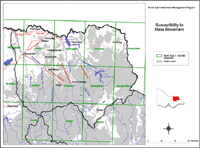Susceptibility to Mass Movement
 Susceptibility to Mass Movement |
Mass movement encompasses erosion processes in which gravity is the primary force acting to dislodge and transport land surface materials. It is a function of the gravitational stress acting on the land surface and the resistance of the surface soils and/or rock materials to dislodgement. When the gravitational stress exceeds this resistance, mass movement occurs. The occurrence of mass movement depends on the interaction of various factors including landform, lithology, soil type, rainfall intensity and duration, drainage characteristics and vegetation cover.
Landslip is seldom the result of a single factor as failure is the end result of activities and processes that have taken place over many years prior to the actual movement. In general, failures occur when the weight of the slope exceeds its restraining capacity. The most common triggering agent is the infiltration of water into the sloping land surface, which has the effect of both reducing the shear strength of the soil material and increasing the mass loading on the slope.
To view the information PDF requires the use of a PDF reader. This can be installed for free from the Adobe website (external link).
(PDF 574KB)
Within the study area there are a number of steeply sloping areas which may be susceptible to landslip if not managed correctly. The land characteristics and management factors involved in mass movement or landslip are described in Table 7.
Table 7 Land characteristics and management factors involved in mass movement
| Processes | Land features affecting processes | Factors affected by land characteristics | Management factors that modify land characteristics |
| Landsliding occurs when the shear forces exceed soil/regolith strength; this generally occurs when soil/regolith strength is reduced by an increase in water | Vegetation
|
| All aspects of the vegetation are affected by selection of species and control of biomass by practices such as cultivating clearing trafficking fertilizing grazing trampling burning |
| Processes involved are: | Climate
| Soil water content | |
infiltration ofwater
| Geology
|
| |
| Topography
|
| |
Other processes that may be involved include:
| Soil
| Soil
| Compaction and soil disruption by stock and vehicles, and by cultivating, will affect profile permeability |


